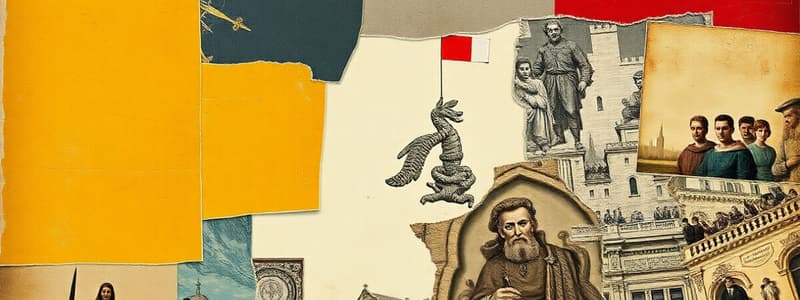Podcast
Questions and Answers
What led to the borrowing of money by monarchs?
What led to the borrowing of money by monarchs?
- Expansion of territories
- Public debt from wars (correct)
- Development of trade routes
- Increase in agricultural productivity
What was a significant change in the nature of warfare during the Late Middle Ages?
What was a significant change in the nature of warfare during the Late Middle Ages?
- Use of bows as the primary weapon
- Emphasis on cavalry units
- Shift from king vs noble to king vs king (correct)
- Increased reliance on sieges
What characterized the composition of armies in the Late Middle Ages?
What characterized the composition of armies in the Late Middle Ages?
- Recruitment was primarily through voluntary enlistment
- Nobles led the majority of forces
- Mercenaries replaced feudal armies (correct)
- Uniforms were mandatory for all soldiers
What was one of the primary roles of towns in relation to monarchs?
What was one of the primary roles of towns in relation to monarchs?
How did public debt affect the nobility's relationship with kings?
How did public debt affect the nobility's relationship with kings?
What was a major factor contributing to the high casualty rates among soldiers?
What was a major factor contributing to the high casualty rates among soldiers?
Which component of society played a role in the governance of composite states such as Poland and Lithuania?
Which component of society played a role in the governance of composite states such as Poland and Lithuania?
What was a result of the new technologies and ideas during the Late Middle Ages?
What was a result of the new technologies and ideas during the Late Middle Ages?
Flashcards
Public Debt in the Late Middle Ages
Public Debt in the Late Middle Ages
The practice of monarchs borrowing money from bankers to finance wars, luxury spending, and other expenses.
Hereditary Thrones
Hereditary Thrones
A system where the right to a throne is passed down through a family lineage, preventing nobles from maintaining independent armies and making them more reliant on the king.
Privileges of Towns
Privileges of Towns
The exclusive rights and privileges granted to towns, often including the right to self-governance, taxation, and exemption from royal interference.
Cortes
Cortes
Signup and view all the flashcards
Gunpowder and Warfare
Gunpowder and Warfare
Signup and view all the flashcards
Mercenaries and Standing Armies
Mercenaries and Standing Armies
Signup and view all the flashcards
Composite States
Composite States
Signup and view all the flashcards
Medieval Social Order
Medieval Social Order
Signup and view all the flashcards
Study Notes
Limits to State Authority
- Monarchs' authority was limited by traditional rights of towns and nobles.
- Frequent need for money (wars, luxury) led to borrowing from bankers.
- This dependence increased the power of bankers in relation to monarchs.
- Gradually, monarchs became more powerful, aiming to control nobles’ private armies and to reduce their leverage.
Medieval Continuities
- European society continued to be structured around three main groups: clergy, nobles, and peasants.
- Despite changes, core social structures in Europe remained somewhat consistent.
Transforming Discoveries
- Warfare, technology, exploration, and the printing press significantly impacted European society during the late Middle Ages.
- Warfare shifted from dynastic conflicts to larger, more organized battles due to new technologies like gunpowder.
- The printing press facilitated the spread of ideas and knowledge, leading to cultural and intellectual changes.
Medieval Legacies and Warfare
- Gunpowder, developed earlier, revolutionized warfare in Europe.
- Use of gunpowder led to larger, more formalized armies with professional soldiers.
- Larger ships integrated cannons; fortifications enhanced, leading to more complex military structures.
- Mercenaries filled armies as feudal armies decreased.
- Soldiers faced severe conditions, high mortality due to disease, and harsh discipline.
The Printing Press and the Power of the Printed Word
- The printing press reduced the cost and time to produce documents, widely disseminating information.
- Before the press, books were rare and expensive.
- This spread of information dramatically changed European culture and society.
- Printing allowed for the mass production of books and literacy rates increased.
Studying That Suits You
Use AI to generate personalized quizzes and flashcards to suit your learning preferences.




